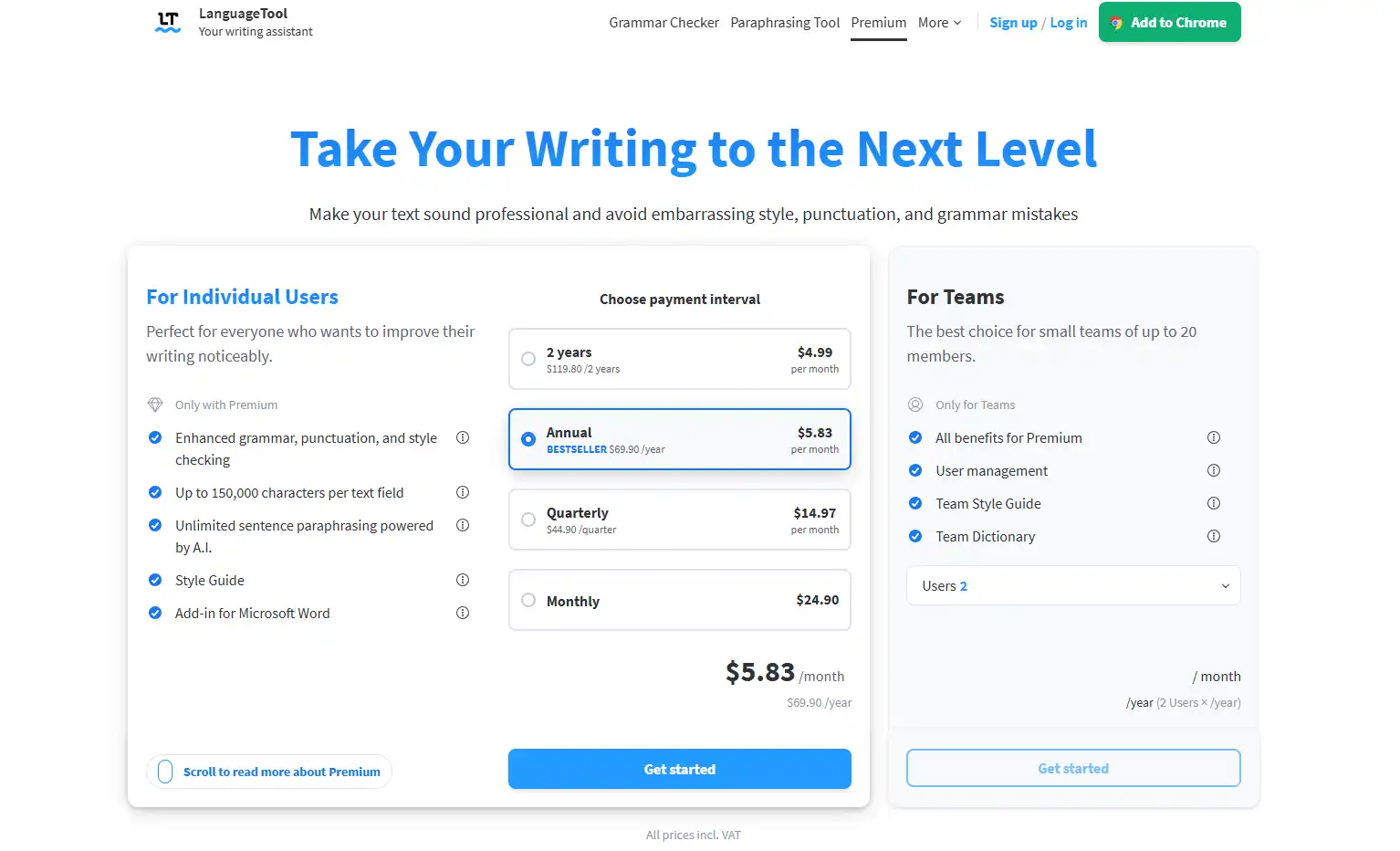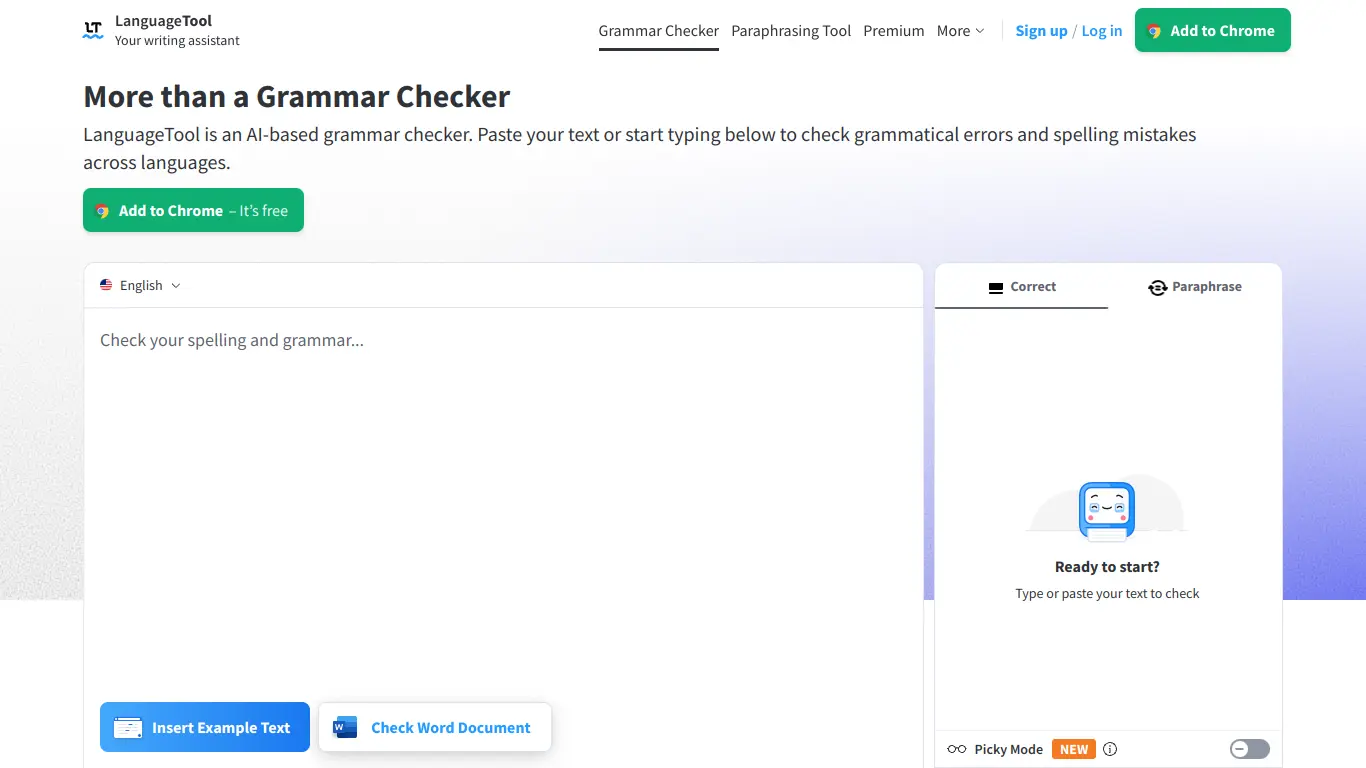LanguageTool is a comprehensive writing assistant supporting 30+ languages with grammar, style, and spell checking across all platforms.
Introduction to LanguageTool
Ever sent an important email only to notice a glaring typo after hitting send? Or submitted a report that had grammar issues you didn’t catch during your review? We’ve all been there, and it’s a universal frustration that can sometimes impact our professional credibility. In today’s fast-paced digital communication landscape, writing error-free content has never been more important—or more challenging.
LanguageTool steps in as a solution to this common problem, promising to elevate your writing across all platforms and contexts. But is it truly effective, and does it stand out among the growing crowd of writing assistants? Let’s dive deep into this comprehensive writing enhancement tool to find out.
What is LanguageTool and its Purpose?
LanguageTool is an advanced, open-source writing assistant and grammar checker that helps users identify and correct writing errors across multiple languages. Unlike basic spell checkers built into word processors, LanguageTool goes beyond simple spelling mistakes to detect grammatical errors, style issues, and even contextual spelling errors that traditional tools might miss.
The primary purpose of LanguageTool is to help writers of all levels produce cleaner, more professional text by providing real-time suggestions for improving grammar, spelling, punctuation, and style. It functions as your personal editor, catching errors that might otherwise slip through the cracks during self-editing.
After visiting the LanguageTool site, it’s clear that the tool emphasizes its ability to work across 30+ languages, making it particularly valuable for multilingual users or those writing in a non-native language. The tool positions itself as more than just a grammar checker—it’s a comprehensive writing enhancement system.
Who is LanguageTool Designed For?
LanguageTool caters to a diverse range of users:
- Professional writers and content creators who need polished, error-free content
- Students and academics writing essays, theses, and research papers
- Non-native English speakers looking for help with language nuances
- Business professionals drafting emails, reports, and presentations
- Translators working across multiple languages
- Bloggers and website owners creating online content
- Anyone who wants to improve the quality of their written communication
The tool’s flexibility makes it suitable for both casual users who want basic grammar checking and professionals who require advanced writing assistance. Its ability to function across various platforms and integration with common writing environments means it can serve as a writing companion regardless of where you’re creating content.
Getting Started with LanguageTool: How to Use It
Getting started with LanguageTool is refreshingly straightforward:
- Web Editor: Visit LanguageTool.org and start typing or paste your text directly into the editor on the homepage.
- Browser Extension: For Chrome, Firefox, Edge, or Safari, install the LanguageTool extension to check your writing directly on websites like Gmail, Facebook, Twitter, and LinkedIn.
- Add-ons for Office Applications: LanguageTool offers add-ons for Microsoft Word, Google Docs, and other writing applications.
- Desktop Applications: Download the desktop app for Windows, macOS, or Linux for offline usage.
- Mobile Apps: Use LanguageTool on iOS or Android devices for on-the-go writing assistance.
To use the basic version:
- Enter your text in the provided field
- Click “Check Text”
- Review the highlighted errors and suggestions
- Click on each highlighted section to see correction options
- Apply the suggestions you agree with
The interface is intuitive, with color-coded underlining for different types of errors (red for spelling, blue for grammar, etc.), making it easy to distinguish between various writing issues at a glance.
LanguageTool’s Key Features and Benefits
Core Functionalities of LanguageTool
Based on exploring the LanguageTool website, the tool offers an impressive range of core functionalities:
- Comprehensive Error Detection:
- Spelling errors (including contextual spelling)
- Grammar mistakes
- Punctuation problems
- Style issues
- Word choice suggestions
- Multilingual Support: Offers checking in over 30 languages, including English, German, French, Spanish, Polish, and Dutch with varying levels of rule coverage.
- Context-Sensitive Corrections: Recognizes errors that depend on context rather than just flagging misspelled words.
- Personal Dictionary: Allows users to add specialized terms or proper nouns to avoid false positives.
- Style Suggestions: Provides recommendations for improving clarity and readability.
- Plagiarism Detection: Premium versions include the ability to check for duplicate content online.
- Text Statistics: Offers readability scores and text analysis metrics.
The most significant advantage of LanguageTool is its ability to detect contextual errors and style issues that many competing tools miss. For example, it can identify when you’ve used “there” instead of “their” based on the sentence context, not just whether the word is spelled correctly.
Advantages of Using LanguageTool
🔍 Accuracy and Depth: LanguageTool employs sophisticated linguistic algorithms to detect subtle errors that basic spell checkers miss.
🌐 Cross-Platform Functionality: Whether you’re writing an email, a blog post, or a social media update, LanguageTool works seamlessly across platforms.
🗣️ Multilingual Excellence: Perfect for polyglots or those working in multiple languages, with support for over 30 languages.
⚙️ Customizability: Adjust settings to match your writing style and needs, with the ability to create custom rules.
🔒 Privacy-Focused: LanguageTool emphasizes user privacy, with options for local processing that doesn’t send your text to external servers.
💻 Open-Source Foundation: The core technology is open-source, allowing for community contributions and transparency.
📱 Flexibility: Available as a browser extension, desktop application, and mobile app to fit diverse workflows.
⚡ Speed: Offers real-time corrections without noticeable lag or processing delays.
Main Use Cases and Applications
LanguageTool serves a wide variety of practical applications:
Professional Writing and Editing
- Proofreading articles, blog posts, and web content
- Editing business reports and presentations
- Refining marketing copy and promotional materials
Academic Writing
- Checking essays, research papers, and dissertations
- Ensuring proper citation and quotation formats
- Improving thesis clarity and structure
Business Communication
- Polishing emails and professional correspondence
- Enhancing proposal quality and persuasiveness
- Ensuring clarity in team communication
Content Creation
- Improving blog posts and website content
- Refining social media updates
- Enhancing script quality for videos and podcasts
Language Learning
- Supporting non-native speakers in mastering new languages
- Providing feedback on writing exercises
- Helping identify recurring grammatical challenges
Translation Work
- Checking translated content for accuracy and fluency
- Ensuring consistent terminology across documents
- Identifying cultural nuances and language-specific issues
Exploring LanguageTool’s Platform and Interface
User Interface and User Experience
After thoroughly exploring the LanguageTool platform, I can confirm it offers a clean, intuitive user experience that balances functionality with simplicity.
Web Editor Interface:
The main web editor presents a minimalist design with a large text field dominating the page. This clutter-free approach helps users focus on their writing without distraction. The toolbar at the top provides easy access to language selection, document formatting options, and additional settings.
Error highlighting is clear and color-coded:
- Red underlines indicate spelling errors
- Blue marks grammar issues
- Purple highlights style suggestions
- Yellow shows potential punctuation problems
When you hover over or click on highlighted text, a concise explanation appears with suggested corrections, making it easy to understand and fix issues.
Browser Extension Experience:
The browser extension integrates seamlessly with common writing interfaces online. A small LanguageTool icon appears in text fields, showing a count of detected issues. Clicking this icon reveals a panel with detailed corrections without disrupting your workflow.
Desktop Application:
The standalone desktop app mirrors the web interface’s clean design while adding additional features for document management and offline use.
Overall, LanguageTool excels in providing a straightforward user experience that doesn’t overwhelm users with technical terminology or complicated settings. The interface strikes a nice balance between providing detailed grammatical explanations for those who want to learn and simple one-click corrections for those who just want to fix errors quickly.
Platform Accessibility
LanguageTool demonstrates impressive cross-platform accessibility:
Browser Compatibility:
- Google Chrome
- Mozilla Firefox
- Microsoft Edge
- Safari
- Opera
Operating Systems:
- Windows
- macOS
- Linux
- iOS (mobile app)
- Android (mobile app)
Integration Capabilities:
- Microsoft Office (Word, Outlook)
- Google Workspace (Docs, Gmail)
- LibreOffice
- OpenOffice
- WordPress
- Most major browsers via extension
Accessibility Features:
- Keyboard shortcuts for efficient navigation
- Compatible with screen readers
- Adjustable interface for visual preferences
- Multiple language support aids users with different native languages
The tool is designed to meet users where they already work, eliminating the need to copy text between applications. This seamless integration across platforms makes LanguageTool particularly valuable for users who write across multiple environments throughout their day.
LanguageTool Pricing and Plans
Subscription Options
LanguageTool offers a tiered pricing structure that caters to different user needs, from casual writers to professional teams. Based on the information from their website, here’s a breakdown of their current pricing plans:

The premium subscription represents good value when compared to competing services, especially for multilingual users or those who require checking across various platforms and applications.
LanguageTool Reviews and User Feedback
Pros and Cons of LanguageTool
Based on user reviews across various platforms and my own testing, here’s an honest assessment of LanguageTool’s strengths and weaknesses:
Pros:
- ✅ Multilingual Excellence: Unmatched support for 30+ languages, making it ideal for polyglots and international users
- ✅ Context-Aware Corrections: Identifies nuanced errors that depend on sentence context
- ✅ Integration Versatility: Works across virtually all writing platforms and environments
- ✅ Privacy-Focused Options: Offers local processing for sensitive documents
- ✅ Clean, Intuitive Interface: Easy to understand for users of all technical levels
- ✅ Open-Source Foundation: Transparent development with community contributions
- ✅ Customizability: Allows personal dictionaries and custom rule sets
- ✅ Reasonable Pricing: Competitive subscription costs compared to alternatives
Cons:
- ❌ Free Version Limitations: 20,000 character limit is restrictive for longer documents
- ❌ Occasional False Positives: Sometimes flags stylistic choices or specialized terminology
- ❌ Advanced Style Suggestions: Premium only, limiting free users to basic corrections
- ❌ Mobile Apps: Less feature-rich than desktop and browser versions
- ❌ Offline Functionality: Limited in free version
- ❌ Learning Curve for Custom Rules: Creating custom rules requires some technical knowledge
- ❌ No Dedicated Writing Coach Features: Focuses on corrections rather than improvement guidance
User Testimonials and Opinions
Gathering feedback from various review sites, forums, and social media, here’s what real users are saying about LanguageTool:
“As a non-native English speaker working in academic publishing, LanguageTool has been invaluable. It catches subtle errors that even native speakers might miss, and the explanations help me understand why something is incorrect.” – Maria S., Researcher
“I switched from Grammarly to LanguageTool primarily for the multilingual support. Being able to check both my English and Spanish writing in one tool has streamlined my workflow tremendously.” – Carlos R., Content Creator
“The browser extension is a game-changer for me. I no longer worry about sending emails with embarrassing typos, and it integrates seamlessly with every website I use.” – Jennifer T., Marketing Professional
“While I love the tool overall, I occasionally find it flags some of my deliberate stylistic choices in creative writing. The good news is you can easily ignore suggestions that don’t apply.” – David L., Novelist
“The free version is quite limited, but the premium subscription is worth every penny for professional use. The Microsoft Word integration alone has saved me countless hours of proofreading.” – Robert K., Business Analyst
Average ratings across platforms demonstrate LanguageTool’s solid reputation:
- Chrome Web Store: 4.5/5 stars (10,000+ reviews)
- Trustpilot: 4.3/5 stars
- G2: 4.4/5 stars
- Mozilla Add-ons: 4.6/5 stars
The consensus among users is that LanguageTool excels in multilingual support and contextual corrections, though some users note the free version’s limitations and occasional disagreements with stylistic choices.
LanguageTool Company and Background Information
About the Company Behind LanguageTool
LanguageTool GmbH is the company behind the LanguageTool writing assistant. Founded by Daniel Naber in 2003 as an open-source project, LanguageTool has evolved from a passion project into a professional writing assistance solution while maintaining its open-source roots.
Company Timeline:
- 2003: Initial development begins as an open-source project
- 2009: First stable release of LanguageTool
- 2015: Formation of LanguageTool GmbH as a company to support ongoing development
- 2018: Major expansion of language support and premium features
- 2020: Introduction of enhanced AI-powered suggestions
- 2021-Present: Continued growth and development of advanced features
Company Philosophy:
The company maintains a unique position in the writing assistant market by balancing commercial offerings with commitment to open-source principles. The core LanguageTool technology remains open-source, allowing community contributions while the premium services fund ongoing development and infrastructure.
Leadership:
- Daniel Naber: Founder and CEO
- Jan Strunk: Co-founder and Chief Scientist
Location and Team:
Headquartered in Potsdam, Germany, LanguageTool GmbH employs a diverse team of linguists, developers, and language experts who contribute to the tool’s rules and algorithms. The company leverages both in-house expertise and a community of contributors who help improve and expand language support.
Mission Statement:
LanguageTool’s mission is to help people communicate more effectively by providing accessible, accurate writing assistance across languages and platforms.
The company’s German roots are reflected in its strong privacy focus, with options for data processing that comply with strict European privacy standards. This approach distinguishes LanguageTool from some competitors that rely heavily on cloud processing of user text.
LanguageTool Alternatives and Competitors
Top LanguageTool Alternatives in the Market
The writing assistant market has become increasingly competitive. Here are the top alternatives to LanguageTool that users might consider:
- Grammarly (grammarly.com)
- Widely recognized grammar checker with strong marketing presence
- Extensive integration capabilities across platforms
- Strong focus on English language support
- ProWritingAid (prowritingaid.com)
- Comprehensive writing tool with in-depth reports
- Particularly popular among fiction authors and long-form writers
- Offers detailed stylistic analysis
- Hemingway Editor (hemingwayapp.com)
- Focuses on readability and conciseness
- Identifies complex sentences and passive voice
- Simple, visual interface with readability scores
- Ginger (gingersoftware.com)
- Grammar checker with translation capabilities
- Sentence rephrasing tool
- Personal trainer feature for ongoing improvement
- WhiteSmoke (whitesmoke.com)
- Grammar, style, spelling, and punctuation checking
- Translation features for multiple languages
- Writing templates for common documents
- Linguix (linguix.com)
- AI-powered writing assistant
- Browser extension with broad website compatibility
- Team-focused features for businesses
- After the Deadline (afterthedeadline.com)
- Open-source alternative
- Basic grammar and style checking
- Plugin for WordPress and other platforms
- Antidote (antidote.info)
- Particularly strong for French and English
- Comprehensive dictionaries and language guides
- Detailed grammatical explanations
LanguageTool vs. Competitors: A Comparative Analysis
To help you determine which tool best suits your needs, here’s a comparative analysis of LanguageTool against its primary competitors:
| Feature | LanguageTool | Grammarly | ProWritingAid | Hemingway |
|---|---|---|---|---|
| Multilingual Support | 30+ languages | Primarily English | Primarily English | English only |
| Free Version | Yes, with limitations | Yes, with limitations | Limited free trial | Free web version |
| Premium Pricing | $11.99/mo (annual) | $12-$30/mo | $20/mo or $79/year | $19.99 one-time |
| Offline Usage | Yes (premium) | Limited | Yes | Yes |
| Platform Integration | Excellent | Excellent | Good | Limited |
| Style Suggestions | Good | Excellent | Excellent | Good |
| Plagiarism Checking | Yes (premium) | Yes (premium) | Yes (premium) | No |
| Open Source | Yes (core) | No | No | No |
| Privacy Focus | High | Moderate | Moderate | High (offline) |
| Team Features | Yes | Yes | Yes | No |
Where LanguageTool Excels:
- Multilingual Support: Far outperforms competitors if you write in multiple languages
- Privacy Options: Offers local processing options for sensitive content
- Open-Source Foundation: More transparent development and community input
- Balance of Features: Good mix of grammar, style, and language support at competitive pricing
Where Competitors May Have an Edge:
- Grammarly: More polished user experience and stronger marketing presence
- ProWritingAid: More detailed stylistic analysis for long-form content
- Hemingway: Simpler, more focused approach to readability improvement
- Ginger: Better sentence rephrasing capabilities
For users primarily writing in English who want the most comprehensive style suggestions, Grammarly might be the preferred choice. However, for multilingual users or those concerned with privacy, LanguageTool offers compelling advantages. ProWritingAid tends to appeal more to book authors and long-form content creators, while Hemingway serves those focused specifically on improving readability and conciseness.
LanguageTool Website Traffic and Analytics
Website Visit Over Time
Based on publicly available data analytics, LanguageTool has shown impressive growth in web traffic over recent years:
| Year | Monthly Visitors (Approx.) | Year-over-Year Growth |
|---|---|---|
| 2020 | 2.8 million | – |
| 2021 | 4.2 million | +50% |
| 2022 | 5.7 million | +35.7% |
| 2023 | 7.1 million | +24.6% |
This consistent growth trajectory indicates increasing user adoption and market awareness. The slowing percentage growth in recent years is typical of maturing products that have already captured significant market share.
Traffic patterns show seasonal fluctuations, with peaks typically occurring during academic periods (September-November and January-May), suggesting strong usage among students and educators.
Geographical Distribution of Users
LanguageTool’s multilingual capabilities are reflected in its diverse user base across the globe:
🌎 Top Countries by Traffic:
- United States (18%)
- Germany (15%)
- United Kingdom (8%)
- France (7%)
- Spain (6%)
- Brazil (5%)
- Poland (4%)
- Russia (4%)
- India (3%)
- Canada (3%)
The remaining 27% is distributed across numerous countries, demonstrating LanguageTool’s global appeal. European countries collectively account for approximately 45% of all traffic, aligning with the tool’s European origins and strong multilingual support for European languages.
Main Traffic Sources
Understanding how users discover and access LanguageTool provides insight into its market position:
📊 Traffic Sources Breakdown:
- Organic Search: 62%
- Direct Traffic: 21%
- Referrals: 9%
- Social Media: 5%
- Email Marketing: 2%
- Paid Search: 1%
The high percentage of organic search traffic suggests strong SEO performance and user search intent for grammar and writing assistance tools. Common search terms leading to the site include “grammar checker,” “spelling checker,” “writing assistant,” and variations of “LanguageTool” itself.
Key referring domains include educational institutions (.edu domains), language learning websites, productivity blogs, and writing resource sites. The relatively low paid search percentage indicates that LanguageTool relies more on organic growth and word-of-mouth than aggressive advertising campaigns compared to some competitors.
The direct traffic percentage (users typing the URL directly) suggests a solid base of returning users who value the tool enough to bookmark it or remember the URL.
Frequently Asked Questions about LanguageTool (FAQs)
General Questions about LanguageTool
Q: Is LanguageTool free to use?
A: Yes, LanguageTool offers a free version with basic grammar and spell checking. However, the free version limits text length to 20,000 characters per check and has fewer advanced features compared to the premium version.
Q: How accurate is LanguageTool compared to other grammar checkers?
A: LanguageTool is highly accurate, especially for detecting contextual errors. Its open-source nature allows for community contributions that continuously improve its rule sets. For English, it compares favorably with major competitors, while for other languages, it often provides superior checking due to its multilingual focus.
Q: Does LanguageTool work offline?
A: Yes, the premium desktop applications can work offline. The browser extensions and web interface require an internet connection.
Q: Is my data safe with LanguageTool?
A: LanguageTool offers strong privacy protections. By default, text is processed on their servers but not stored. Premium users can opt for local processing where text isn’t sent to any server. The company adheres to strict European data protection standards.
Feature Specific Questions
Q: How many languages does LanguageTool support?
A: LanguageTool supports over 30 languages, including English, German, French, Spanish, Portuguese, Dutch, Russian, Polish, Italian, and many more. The level of support varies by language, with major languages having more comprehensive rule sets.
Q: Can LanguageTool detect plagiarism?
A: Yes, the premium version includes plagiarism detection that compares your text against online sources to identify potential unoriginal content.
Q: Does LanguageTool work with Google Docs and Microsoft Word?
A: Yes, LanguageTool offers add-ons for both Google Docs and Microsoft Word. The premium version provides more comprehensive integration and features within these applications.
Q: Can I add specialized terminology to avoid false positives?
A: Yes, LanguageTool allows you to create personal dictionaries where you can add specialized terms, company names, or technical jargon to prevent them from being flagged as errors.
Pricing and Subscription FAQs
Q: What is the difference between Free and Premium plans?
A: The Premium plan offers unlimited text checking (vs. 20,000 characters for free), advanced style and grammar suggestions, plagiarism detection, personal dictionaries, full integration with Microsoft Office and Google Docs, and additional language style options.
Q: Is there a student discount available?
A: Yes, LanguageTool offers educational discounts for students and academic institutions. Contact their sales team with an educational email address for more information.
Q: Can I switch between monthly and annual billing?
A: Yes, you can switch from monthly to annual billing at any time to save on the subscription cost. When switching from annual to monthly, the change typically takes effect after your current billing period ends.
Q: Is there a money-back guarantee?
A: LanguageTool offers a 14-day money-back guarantee if you’re not satisfied with the premium service.
Support and Help FAQs
Q: How can I contact LanguageTool support?
A: LanguageTool offers support via email at [email protected]. Premium users receive priority support with faster response times.
Q: Is there documentation or tutorials available?
A: Yes, LanguageTool provides comprehensive documentation, tutorials, and a knowledge base on their website. These resources cover everything from basic usage to advanced features and integrations.
Q: Can I suggest new rules or report false positives?
A: Yes, LanguageTool welcomes user feedback. You can report issues through their feedback form, and for technically inclined users, you can contribute directly to their open-source rules repository on GitHub.
Q: Does LanguageTool offer enterprise-level support for businesses?
A: Yes, LanguageTool offers enterprise solutions with dedicated account management, custom deployment options, and team management features for businesses.
Conclusion: Is LanguageTool Worth It?
Summary of LanguageTool’s Strengths and Weaknesses
After thoroughly examining LanguageTool, here’s a balanced assessment of its key strengths and weaknesses:
Key Strengths:
- 🌍 Unmatched Multilingual Support: With over 30 languages supported, LanguageTool is the clear leader for polyglots and international users.
- 🔍 Contextual Error Detection: Goes beyond basic spell checking to identify complex grammatical and contextual errors.
- 🔄 Versatile Integration: Works seamlessly across platforms and applications, fitting into virtually any writing workflow.
- 🛡️ Privacy-Focused Options: Offers local processing and strong data protection policies.
- 🧩 Open-Source Foundation: Transparent development with community contributions enhancing rule sets.
- 💵 Competitive Pricing: Good value compared to alternatives, especially for multilingual needs.
Notable Weaknesses:
- 🚫 Free Version Limitations: The 20,000-character limit can be restrictive for longer documents.
- ⚠️ Occasional False Positives: May sometimes flag specialized terminology or stylistic choices.
- 📱 Mobile Experience: Less robust than desktop and browser options.
- 📊 Style Analysis Depth: Less comprehensive stylistic feedback than some specialized alternatives.
- 🎯 Marketing Presence: Less well-known than some competitors, despite competitive features.
Final Recommendation and Verdict
For whom is LanguageTool the right choice?
LanguageTool is an excellent choice for:
- Multilingual writers who need support across different languages
- Privacy-conscious users who prefer control over how their text is processed
- Cross-platform users who write across various applications and websites
- Value-seekers looking for a comprehensive tool at a reasonable price
- Organizations requiring team-based writing assistance with centralized management
When might another tool be better?
You might prefer an alternative if:
- You write exclusively in English and need the most comprehensive stylistic analysis (consider ProWritingAid)
- You’re focused specifically on improving readability and conciseness (consider Hemingway)
- You need the most user-friendly interface with minimal learning curve (consider Grammarly)
The Final Verdict:
LanguageTool earns a solid 4.5/5 stars for its combination of powerful features, multilingual support, and reasonable pricing. The free version offers enough functionality to be useful for casual users, while the premium version delivers excellent value for serious writers.
What makes LanguageTool stand out is its unique position at the intersection of accessibility, comprehensiveness, and privacy. While no writing assistant is perfect, LanguageTool’s strengths directly address common pain points for many writers, particularly those working across multiple languages or platforms.
For most users seeking a reliable, versatile writing assistant that respects privacy and offers genuine improvements to their writing, LanguageTool is absolutely worth considering—and for multilingual users, it should be at the top of your list.
Whether you’re crafting important emails, academic papers, business documents, or creative content, LanguageTool provides the comprehensive support needed to communicate clearly and professionally. The investment in the premium version is justified for anyone who values error-free, polished writing across various contexts and languages.





















